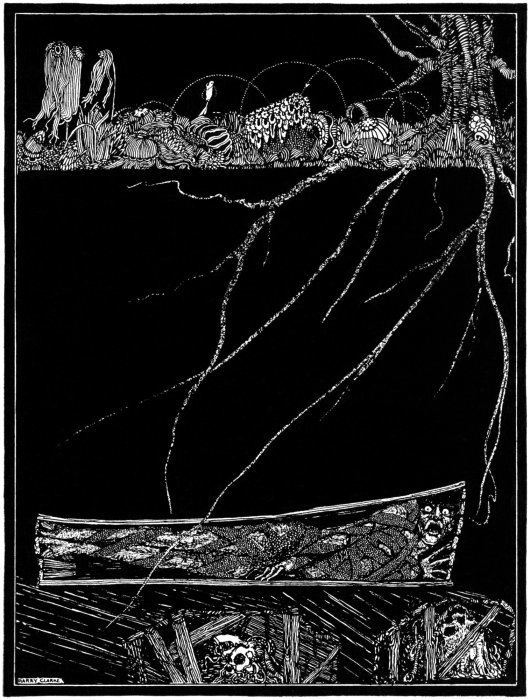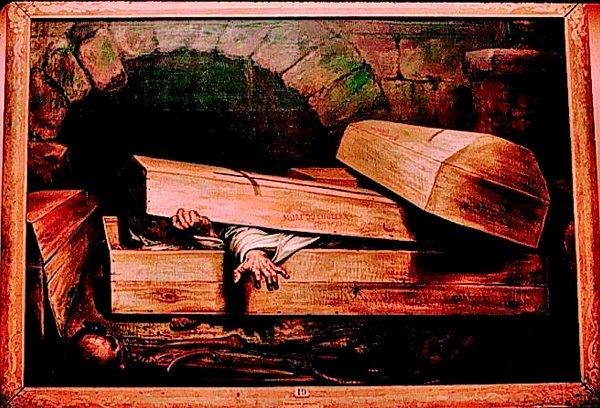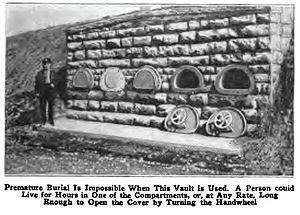 | ||
Premature burial, also known as live burial, burial alive, or vivisepulture, means to be buried while still alive. Animals or humans may be buried alive accidentally or intentionally. The victim may accidentally be buried by others in the mistaken assumption that they are dead. Intentional burial may occur as a form of torture, murder, or execution; it may also occur with consent of the victim as a part of a stunt (with the intention to escape). Fear of being buried alive is reported to be among the most common phobias.
Contents
- 5 real people who were buried alive premature burial
- Biology
- Unintentional live burial
- Attempts to prevent live burial
- Execution by burial
- Modern examples
- Natural disasters
- Wars
- Execution
- Honour killings
- Voluntary burial
- Myths and legends
- References

5 real people who were buried alive premature burial
Biology

Premature burial can lead to death through the following: asphyxiation, dehydration, starvation, or (in cold climates) hypothermia. A person trapped with fresh air to breathe can last a considerable time and burial has been used as a very cruel method of execution (as in cases of Vestal Virgins who violated the oath of celibacy), lasting sufficiently long for the victim to comprehend and imagine every stage of what is happening (being trapped in total darkness with very limited or no movement) and to experience great psychological and physical torment including extreme panic. The medical term for the fear of being buried alive is taphophobia.
Unintentional live burial

At least one (almost certainly apocryphal) report of accidental burial dates back to the fourteenth century. Upon the reopening of his tomb, the philosopher John Duns Scotus (1266-1308) was reportedly found outside his coffin with his hands torn and bloody after attempting to escape. Alice Blunden of Basingstoke was said in a contemporaneous account to have been buried alive, not once but twice, in 1674.

Revivals of supposed "corpses" have been triggered by dropped coffins, grave robbers, embalming, and attempted dissections. Folklorist Paul Barber has argued that the incidence of unintentional live burial has been overestimated, and that the normal, physical effects of decomposition are sometimes misinterpreted as signs that the person whose remains are being exhumed had revived in his or her coffin. Nevertheless, patients have been documented as late as the 1890s as accidentally being sent to the morgue or trapped in a steel box after erroneously being declared dead.

Newspapers have reported cases of exhumed corpses which appear to have been accidentally buried alive. On February 21, 1885, The New York Times gave a disturbing account of such a case. The victim was a man from Buncombe County whose name was given as "Jenkins." His body was found turned over onto its front inside the coffin, with much of his hair pulled out. Scratch marks were also visible on all sides of the coffin's interior. His family were reportedly "distressed beyond measure at the criminal carelessness" associated with the case. Another similar story was reported in The Times on January 18, 1886, the victim of this case being described simply as a "girl" named "Collins" from Woodstock, Ontario, Canada. Her body was described as being found with the knees tucked up under the body, and her burial shroud "torn into shreds."

In 2005, a body bag was delivered to the Matarese Funeral home in Ashland, Massachusetts with a live occupant. Funeral director John Matarese discovered this, called paramedics, and avoided live embalming or premature burial.
In 2014 in Peraia, Thessaloniki, in Macedonia, Greece, the police discovered that a 45-year-old woman was buried alive and died of asphyxia after being declared clinically dead by a private hospital; she was discovered just shortly after being buried by children playing near the cemetery who heard screams from inside the earth and afterwards her family was reported as considering suing the private hospital. In 2015 it was reported that in 2014 again in Peraia, Thessaloniki, in Macedonia, Greece, police investigation concluded that a 49-year-old woman was buried alive after being declared dead due to cancer; her family reported that they could hear her scream from inside the earth at the cemetery shortly after burial and the investigation revealed that she died of heart failure inside the coffin and found out that it was the medicines given to her by her doctors for her cancer that caused her to be declared clinically dead and buried alive.
Attempts to prevent live burial
Robert Robinson died in Manchester in 1791. A movable glass pane was inserted in his coffin, and the mausoleum had a door for purposes of inspection by a watchman, who was to see if he breathed on the glass. He instructed his relatives to visit his grave periodically to check that he was still dead.
Safety coffins were devised to prevent premature burial, although there is no evidence that any have ever been successfully used to save an accidentally buried person. On 5 December 1882, J. G. Krichbaum received U.S. Patent 268,693 for his "Device For Life In Buried Persons." It consisted of a movable periscope-like pipe which provided air and, when rotated or pushed by the person interred, indicated to passersby that someone was buried alive. The patent text refers to "that class of devices for indicating life in buried persons," suggesting that such inventions were common at the time.
In 1890, a family designed and built a burial vault at the Wildwood Cemetery in Williamsport, Pennsylvania, with an internal hatch to allow the victim of accidental premature burial to escape. The vault had an air supply and was lined in felt to protect a panic-stricken victim from self-inflicted injury before escape. Bodies were to be removed from the casket before interment.
The London Association for the Prevention of Premature Burial was co-founded in 1896 by William Tebb and Walter Hadwen.
Execution by burial
Tacitus, in his work Germania, records that German tribes practiced two forms of capital punishment; the first where the victim was hanged from a tree, and another where the victim was tied to a wicker frame, pushed face down into mud and buried. The first was used to make an example of traitors; the second was used for punishment of dishonourable or shameful vices, such as cowardice. According to Tacitus, the Ancient Germans thought that crime should be exposed, whereas infamy should be buried out of sight.
In ancient Rome, a Vestal Virgin convicted of violating her vows of celibacy was "buried alive" by being sealed in a cave with a small amount of bread and water, ostensibly so that the goddess Vesta could save her were she truly innocent. This practice was, strictly speaking, immurement (i.e., being walled up and left to die) rather than premature burial. According to Christian tradition, a number of saints were martyred this way, including Saint Castulus and Saint Vitalis of Milan.
In Denmark, in the Ribe city statute, which was promulgated in 1269, a female thief was to be buried alive, and in the law by Queen Margaret I, adulterous women were to be punished with premature burial, men with beheading.
Within the Holy Roman Empire a variety of offenses including rape, infanticide and theft could be punished with live burial. For example, the Schwabenspiegel, a law code from the 13th century, specified that the rape of a virgin should be punished by live burial (whereas the rapist of a non-virgin was to be beheaded). Female murderers of their own employers also risked being buried alive. In Augsburg 1505, for example, a 12-year-old boy and a 13-year-old girl were found guilty of killing their master, in conspiracy with the cook. The boy was beheaded, and the girl and the cook were buried alive beneath the gallows. The jurist Eduard Henke observed that in the Middle Ages, live burial of women guilty of infanticide was a "very frequent" punishment in city statutes and Landrechten. For example, he notes those in Hesse, Bohemia, Tyrol. The "Berlinisches Stadtbuch" records that between 1412 and 1447, 10 women were buried alive there, and as late as in 1583, the archbishop of Bremen promulgated (alongside the somewhat milder 1532 Constitutio Criminalis Carolina punishment of drowning) live burial as an alternate execution method for punishing mothers found guilty of infanticide.
As noted by Elias Pufendorf, a woman buried alive would afterwards be impaled through the heart. This combined punishment of live burial and impalement was practiced in Nuremberg until 1508 also for women found guilty of theft, but the city council decided in 1515 that the punishment was too cruel, and opted for drowning instead. Impalement was, however, not always mentioned together with live burial. Eduard Osenbrüggen relates how the live burial of a woman convicted of infanticide could be pronounced in a court verdict. For example, in a 1570 case in Ensisheim:
The verdict commanded the executioner to place the perpetrator in the grave alive, "and place two layers of thorns, the one beneath, the other above her. Prior to that he should place a bowl over her face, in which he had made a hole, and to give her through that a reed/tube into the mouth, then jump three times upon her, and lastly cover her with earth"
In this particular case, however, some noblewomen made an appeal for mercy, and the convicted woman was drowned instead.
Dieter Furcht speculates that the impalement was not so much to be regarded as an execution method, but as a way to prevent the condemned from becoming an avenging, undead Wiedergänger. In medieval Italy, unrepentant murderers were buried alive, head down, feet in the air, a practice referred to in passing in Canto XIX of Dante's Inferno.
In the 16th Century Habsburg Netherlands, where the Catholic authorities made a prolonged effort to stamp out the Protestant churches, live burial was commonly used as the punishment of women found guilty of heresy. The last to be so executed was Anna Utenhoven, an Anabaptist buried alive at Vilvoorde in 1597. Reportedly, when her head was still above the ground she was given a last chance to recant her faith, and upon her refusal she was completely covered up and suffocated. The case aroused a great deal of protest in the rebellious north provinces, and foiled the peace feelers which King Philip III was at the time extending to the Dutch. Thereafter the Habsburg authorities avoided further such cases, punishing heresy with fines and deportations rather than death.
Into the seventeenth century in feudal Russia, live burial as execution method was known as "the pit" and used against women who were condemned for killing their husbands. In 1689, the punishment of live burial was changed to beheading Live burial of Jews in such countries as Ukraine is reported; for example some instances occurred during the Chmielnicki Massacre (1648–1649) in Ukraine.
Modern examples
There have been a number of cases of people pronounced incorrectly dead and thereafter buried alive.
Natural disasters
Natural disasters have also largely buried people alive, as well as collapsing mines.
Wars
It has been used during wars and by mafia organizations.
Serbian officials are documented to have buried alive Bulgarian civilians from Pehčevo (now in the Republic of Macedonia) during the Balkan Wars. During World War II, Japanese soldiers were documented to have buried Chinese civilians alive, notably during the Nanking Massacre. This method of execution was also used by German leaders against Jews in Ukraine and Belarus during World War II.
During the Vietnam War (American War), burials alive were documented at the Massacre at Huế in 1968.
During the Gulf War, Iraqi soldiers were knowingly buried alive by American tanks of the First Infantry Division shoveling earth into their trenches. Estimates for the number of soldiers killed this way vary: one source puts it at "between 80 and 250", while Col. Anthony Moreno suggested it may have been thousands.
In 2014 ISIS buried Yazidi women and children alive in an attempt to annihilate the Yazidi tribe.
Execution
There are also accounts of the Khmer Rouge using premature burials as a form of execution in the Killing Fields.
During Mao Zedong's regime, there are some accounts that premature burials were used in executions.
Honour killings
So-called "honour killings" take place every year in Turkey, where people are buried alive, usually by their family, regarding gender roles or only for talking to the opposite sex. In Istanbul alone there is one honor killing every week and over 1,000 reported during the previous five years.
Voluntary burial
On rare occasions, people have willingly arranged to be buried alive, reportedly as a demonstration of their controversial ability to survive such an event. In one story taking place around 1840, Sadhu Haridas, an Indian fakir, is said to have been buried in the presence of a British military officer and under the supervision of the local maharajah, by being placed in a sealed bag in a wooden box in a vault. The vault was then interred, earth was flattened over the site and crops were sown over the place for a very long time. The whole location was guarded day and night to prevent fraud and the site was dug up twice in a ten-month period to verify the burial, before the fakir was finally dug out and slowly revived in the presence of another officer. The fakir said that his only fear during his "wonderful sleep" was to be eaten by underground worms. However, according to current medical science, it is not possible for a human to survive for a period of ten months without food, water, and air. According to other sources the entire burial was 40 days long. The Indian government has since made the act of voluntary premature burial illegal, because of the unintended deaths of individuals attempting to recreate this feat.
The practice of being buried alive is not uncommon in Russia; in 2010 a man died after being buried alive to try to overcome his fear of death but he was crushed to death by the earth on top of him. The following year, another Russian died after being buried overnight in a makeshift coffin "for good luck".
Buried Alive is a controversial art and lecture performance series by art-tech group monochrom. Participants have the opportunity to be buried alive in a coffin for fifteen to twenty minutes. As a framework program monochrom offers lectures about the history of the science of determining death and the medical cultural history of premature burial.
Myths and legends
St. Oran was a druid living on the Island of Iona in Scotland's Inner Hebrides. He became a follower of St. Columba, who brought Christianity to Iona from Ireland in 563 AD. When St. Columba had repeated problems building the original Iona Abbey, citing interference from the Devil, St. Oran offered himself as a human sacrifice and was buried alive. He was later dug up and found to be still alive, but he uttered such words describing what of the afterlife he had seen and how it involved no heaven or hell, that he was ordered to be covered up again. The building of the abbey went ahead, untroubled, and St. Oran's chapel marks the spot where the saint was buried.
In the fourteenth through nineteenth centuries, a popular tale about premature burial in European folklore was the "Lady with the Ring". In the story, a woman who was prematurely buried awakens to frighten a grave robber who is attempting to cut a ring off her finger.
The TV show MythBusters tested the myth to see if someone could survive being buried alive for two hours before being rescued. Host Jamie Hyneman attempted the feat, but when his steel coffin began to bend under the weight of the earth used to cover it, the experiment was aborted.
